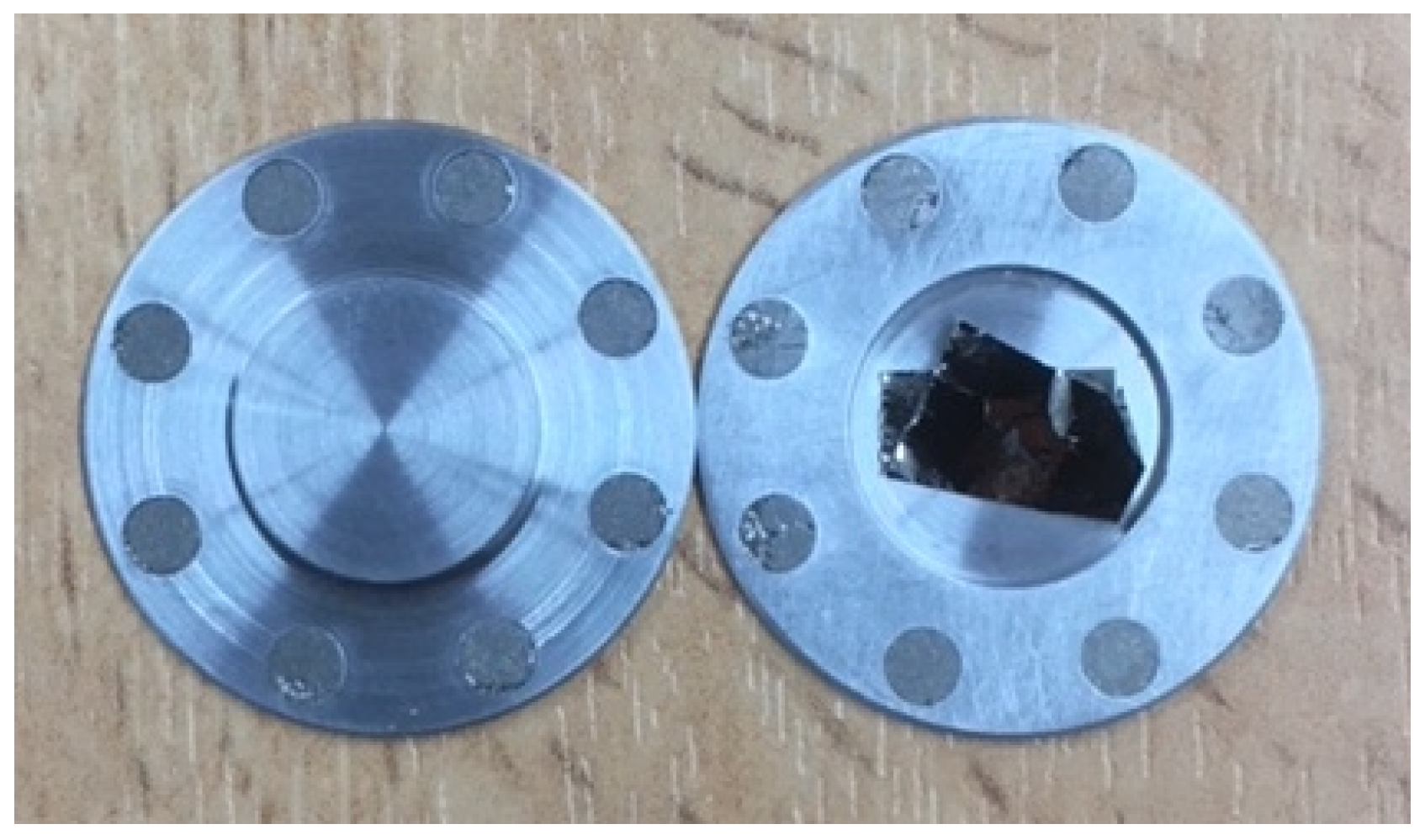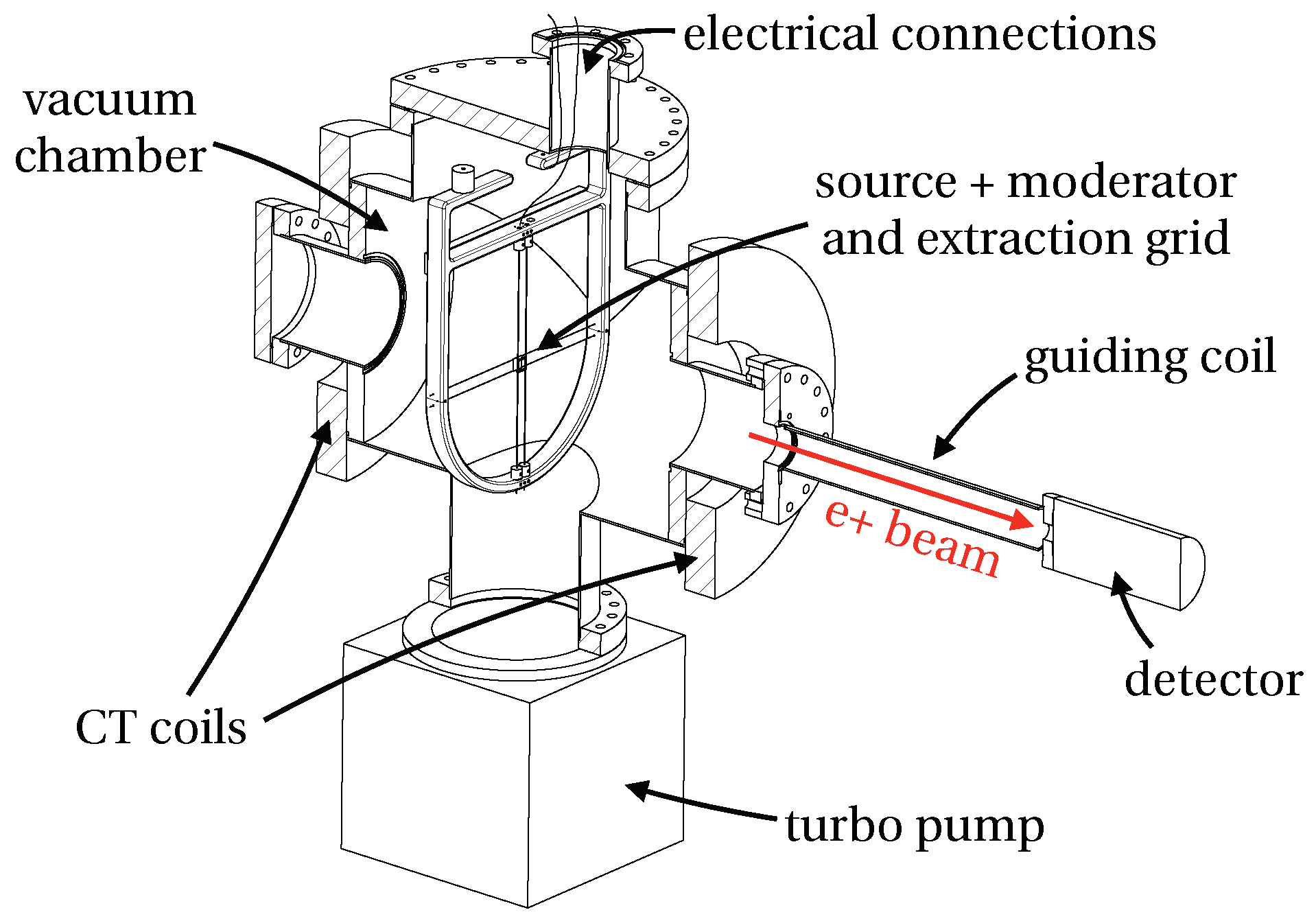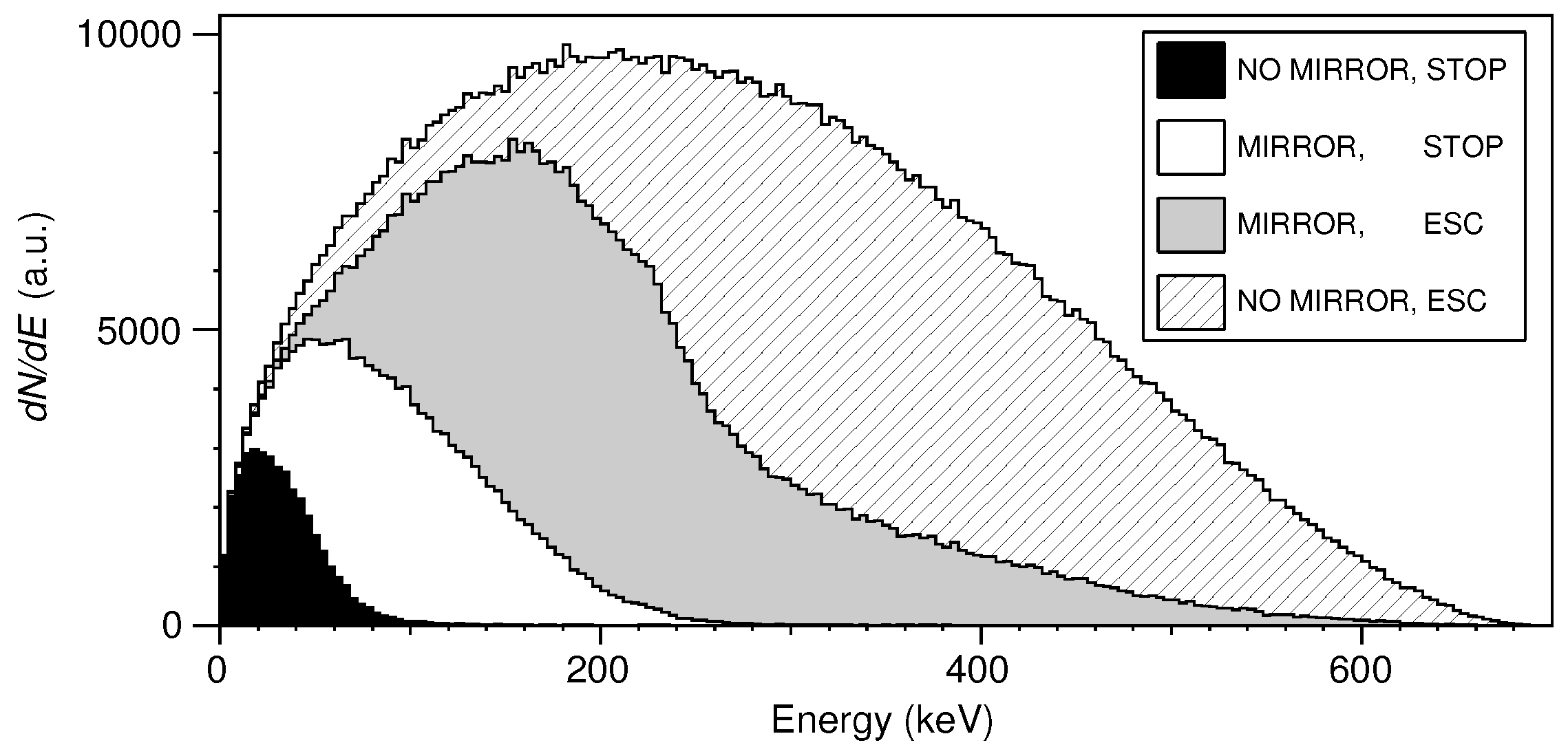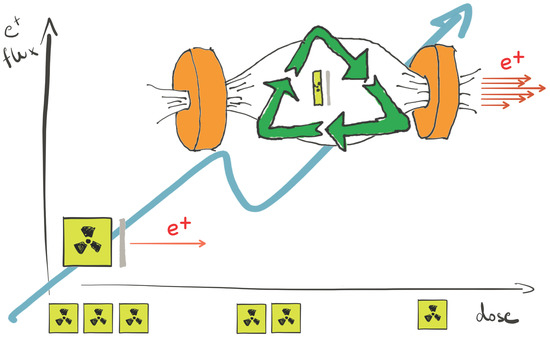High Efficiency Cyclotron Trap Assisted Positron Moderator
Abstract
:1. Introduction
2. Principle of the Cyclotron Trap Assisted Moderation
3. Thin Foil Positon Source
4. Experimental Setup
5. Simulation
6. Results
7. Conclusions
Acknowledgments
Conflicts of Interest
References
- Charlton, M.; Humberston, J.W. Positron Physics; Cambridge University Press: Cambridge, UK, 2001; Volume 11. [Google Scholar]
- Jean, Y.C.; Mallon, P.E.; Schrader, D.M. Principles and Applications of Positron & Positronium Chemistry; World Scientific Publishing: Singapore, 2003. [Google Scholar] [CrossRef]
- Townsend, D.W. Physical principles and technology of clinical PET imaging. Ann. Acad. Med. Singap. 2004, 33, 133–145. [Google Scholar] [PubMed]
- Tuomisto, F.; Makkonen, I. Defect identification in semiconductors with positron annihilation: Experiment and theory. Rev. Mod. Phys. 2013, 85, 1583–1631. [Google Scholar] [CrossRef] [Green Version]
- Eijt, S.W.H.; van Veen, A.T.; Schut, H.; Mijnarends, P.E.; Denison, A.B.; Barbiellini, B.; Bansil, A. Study of colloidal quantum-dot surfaces using an innovative thin-film positron 2D-ACAR method. Nat. Mater. 2006, 5, 23–26. [Google Scholar] [CrossRef] [PubMed]
- Weber, J.A.; Bauer, A.; Böni, P.; Ceeh, H.; Dugdale, S.B.; Ernsting, D.; Kreuzpaintner, W.; Leitner, M.; Pfleiderer, C.; Hugenschmidt, C. Spin-Resolved Fermi Surface of the Localized Ferromagnetic Heusler Compound Cu2MnAl Measured with Spin-Polarized Positron Annihilation. Phys. Rev. Lett. 2015, 115, 206404. [Google Scholar] [CrossRef] [PubMed]
- Jean, Y.C.; Horn, J.D.V.; Hung, W.S.; Lee, K.R. Perspective of Positron Annihilation Spectroscopy in Polymers. Macromolecules 2013, 46, 7133–7145. [Google Scholar] [CrossRef]
- Gidley, D.W.; Peng, H.G.; Vallery, R.S. Positron annihilation as a method to characterize porous materials. Annu. Rev. Mater. Res. 2006, 36, 49–79. [Google Scholar] [CrossRef]
- Milina, M.; Mitchell, S.; Crivelli, P.; Cooke, D.; Pérez-Ramírez, J. Mesopore quality determines the lifetime of hierarchically structured zeolite catalysts. Nat. Commun. 2014, 5, 3922. [Google Scholar] [CrossRef] [Green Version]
- Crivelli, P.; Cooke, D.; Barbiellini, B.; Brown, B.L.; Feldblyum, J.I.; Guo, P.; Gidley, D.W.; Gerchow, L.; Matzger, A.J. Positronium emission spectra from self-assembled metal-organic frameworks. Phys. Rev. B 2014, 89, 241103. [Google Scholar] [CrossRef]
- Surko, C.M.; Gribakin, G.F.; Buckman, S.J. Low-energy positron interactions with atoms and molecules. J. Phys. B 2005, 38, R57. [Google Scholar] [CrossRef]
- Brawley, S.J.; Fayer, S.E.; Shipman, M.; Laricchia, G. Positronium Production and Scattering below Its Breakup Threshold. Phys. Rev. Lett. 2015, 115, 223201. [Google Scholar] [CrossRef] [PubMed]
- Karshenboim, S.G. Precision physics of simple atoms: QED tests, nuclear structure and fundamental constants. Phys. Rep. 2005, 422, 1–63. [Google Scholar] [CrossRef] [Green Version]
- Fee, M.S.; Mills, A.P.; Chu, S.; Shaw, E.D.; Danzmann, K.; Chichester, R.J.; Zuckerman, D.M. Measurement of the positronium 1(3)S(1)-2(3)S(1) interval by continuous-wave 2-photon excitation. Phys. Rev. Lett. 1993, 70, 1397–1400. [Google Scholar] [CrossRef] [PubMed]
- Ishida, A.; Namba, T.; Asai, S.; Kobayashi, T.; Saito, H.; Yoshida, M.; Tanaka, K.; Yamamoto, A. New Precision Measurement of Hyperfine Splitting of Positronium. Phys. Lett. 2014, B734, 338–344. [Google Scholar] [CrossRef] [Green Version]
- Fleischer, F.; Degreif, K.; Gwinner, G.; Lestinsky, M.; Liechtenstein, V.; Plenge, F.; Schwalm, D. Measurement of the decay rate of the negative ion of positronium (Ps(-)). Phys. Rev. Lett. 2006, 96. [Google Scholar] [CrossRef] [PubMed]
- Michishio, K.; Kanai, T.; Kuma, S.; Azuma, T.; Wada, K.; Mochizuki, I.; Hyodo, T.; Yagishita, A.; Nagashima, Y. Observation of a shape resonance of the positronium negative ion. Nat. Commun. 2016, 7. [Google Scholar] [CrossRef] [PubMed]
- Cassidy, D.B.; Hisakado, T.H.; Tom, H.W.K.; Mills, A.P., Jr. Optical Spectroscopy of Molecular Positronium. Phys. Rev. Lett. 2012, 108. [Google Scholar] [CrossRef] [PubMed] [Green Version]
- Vetter, P.A.; Freedman, S.J. Branching ratio measurements of multiphoton decays of positronium. Phys. Rev. A 2002, 66, 052505. [Google Scholar] [CrossRef]
- Yamazaki, T.; Namba, T.; Asai, S.; Kobayashi, T. Search for CP-violation in Positronium Decay. Phys. Rev. Lett. 2010, 104, 083401. [Google Scholar] [CrossRef] [PubMed]
- Badertscher, A.; Crivelli, P.; Fetscher, W.; Gendotti, U.; Gninenko, S.N.; Postoev, V.; Rubbia, A.; Samoylenko, V.; Sillou, D. An Improved Limit on Invisible Decays of Positronium. Phys. Rev. D 2007, 75, 032004. [Google Scholar] [CrossRef]
- Deller, A.; Alonso, A.M.; Cooper, B.S.; Hogan, S.D.; Cassidy, D.B. Electrostatically Guided Rydberg Positronium. Phys. Rev. Lett. 2016, 117. [Google Scholar] [CrossRef] [PubMed] [Green Version]
- Avetissian, H.K.; Avetissian, A.K.; Mkrtchian, G.F. Self-Amplified Gamma-Ray Laser on Positronium Atoms from a Bose-Einstein Condensate. Phys. Rev. Lett. 2014, 113. [Google Scholar] [CrossRef] [PubMed]
- Andresen, G.B.; Ashkezari, M.D.; Baquero-Ruiz, M.; Bertsche, W.; Bowe, P.D.; Butler, E.; Cesar, C.L.; Chapman, S.; Charlton, M.; Deller, A.; et al. Trapped antihydrogen. Nature 2010, 468, 673–676. [Google Scholar] [CrossRef] [PubMed]
- Gabrielse, G.; Kalra, R.; Kolthammer, W.S.; McConnell, R.; Richerme, P.; Grzonka, D.; Oelert, W.; Sefzick, T.; Zielinski, M.; Fitzakerley, D.W.; et al. Trapped Antihydrogen in Its Ground State. Phys. Rev. Lett. 2012, 108, 113002. [Google Scholar] [CrossRef] [PubMed]
- Kuroda, N.; Ulmer, S.; Murtagh, D.J.; Van Gorp, S.; Nagata, Y.; Diermaier, M.; Federmann, S.; Leali, M.; Malbrunot, C.; Mascagna, V.; et al. A source of antihydrogen for in-flight hyperfine spectroscopy. Nat. Commun. 2014, 5, 3089. [Google Scholar] [CrossRef] [PubMed] [Green Version]
- Testera, G.; Aghion, S.; Amsler, C.; Ariga, A.; Ariga, T.; Belov, A.; Bonomi, G.; Braunig, P.; Bremer, J.; Brusa, R.; et al. The AEgIS experiment. Hyperfine Interact. 2015, 233, 13–20. [Google Scholar] [CrossRef]
- Perez, P.; Banerjee, D.; Biraben, F.; Brook-Roberge, D.; Charlton, M.; Clade, P.; Comini, P.; Crivelli, P.; Dalkarov, O.; Debu, P.; et al. The GBAR antimatter gravity experiment. Hyperfine Interact. 2015, 233, 21–27. [Google Scholar] [CrossRef]
- Coleman, P.G. (Ed.) Positron Beams and Their Applications; World Scientific Publishing: Singapore, 2000. [Google Scholar] [CrossRef]
- Danielson, J.R.; Dubin, D.H.E.; Greaves, R.G.; Surko, C.M. Plasma and trap-based techniques for science with positrons. Rev. Mod. Phys. 2015, 87, 247–306. [Google Scholar] [CrossRef] [Green Version]
- Krause-Rehberg, R.; Brauer, G.; Jungmann, M.; Krille, A.; Rogov, A.; Noack, K. Progress of the intense positron beam project EPOS. Appl. Surf. Sci. 2008, 255, 22–24. [Google Scholar] [CrossRef] [Green Version]
- Oshima, N.; Suzuki, R.; Ohdaira, T.; Kinomura, A.; Narumi, T.; Uedono, A.; Fujinami, M. Development of Positron Microbeam in AIST. In Positron and Positronium Chemistry; Trans Tech Publications: Stafa-Zurich, Switzerland, 2009; Volume 607, pp. 238–242. [Google Scholar] [CrossRef]
- Patrice, P.; Laszlo, L.; Jean-Michel, R.; Valentin, B.; Mickael, C.; Aline, C.; Olivier, D.; Pierre, D.; Tomoko, M.; Nicolas, R.; et al. A mini linac based positron source. Phys. Status Solidi C 2009, 6, 2462–2464. [Google Scholar] [CrossRef]
- Schut, H.; van Veen, A.; Falub, C.; de Roode, J.; Labohm, F. Performance of an Intense Nuclear-Reactor Based Positron Beam. In Positron Annihilation—ICPA-12, Proceedings of the 12th International Conference on Positron Annihilation, Munchen, Germany, 6–12 August 2000; Trans Tech Publications: Stafa-Zurich, Switzerland, 2001; Volume 363, pp. 430–432. [Google Scholar] [CrossRef]
- Hawari, A.I.; Gidley, D.W.; Moxom, J.; Hathaway, A.G.; Mukherjee, S. Operation and testing of the PULSTAR reactor intense slow positron beam and PALS spectrometers. In Proceedings of the 12th International Workshop on Slow Positron Beam Techniques, (SLOPOS12), North Queensland, Australia, 1–6 August 2010; Buckman, S.J., Sullivan, J.P., Makochekanwa, C., White, R., Eds.; Institute of Physics Publishing: Bristol, UK, 2011; Volume 262. [Google Scholar] [CrossRef]
- Hugenschmidt, C.; Ceeh, H.; Gigl, T.; Lippert, F.; Piochacz, C.; Reiner, M.; Schreckenbach, K.; Vohburger, S.; Weber, J.; Zimnik, S. Positron Beam Characteristics at NEPOMUC Upgrade. In Proceedings of the 13th International Workshop on Slow Positron Beam Techniques and Applications (SLOPOS13), Munich, Germany, 15–20 September 2013; Hugenschmidt, C., Piochacz, C., Eds.; Institute of Physics Publishing: Bristol, UK, 2014; Volume 505. [Google Scholar] [CrossRef]
- Chen, H.; Wilks, S.C.; Bonlie, J.D.; Liang, E.P.; Myatt, J.; Price, D.F.; Meyerhofer, D.D.; Beiersdorfer, P. Relativistic Positron Creation Using Ultraintense Short Pulse Lasers. Phys. Rev. Lett. 2009, 102, 105001. [Google Scholar] [CrossRef] [PubMed]
- Lynn, K.G.; Nielsen, B.; Quateman, J.H. Development and use of a thin film transmission positron moderator. Appl. Phys. Lett. 1985, 47, 239–240. [Google Scholar] [CrossRef]
- Mills, A.P.; Gullikson, E.M. Solid neon moderator for producing slow positrons. Appl. Phys. Lett. 1986, 49, 1121–1123. [Google Scholar] [CrossRef]
- Saito, F.; Nagashima, Y.; Wei, L.; Itoh, Y.; Goto, A.; Hyodo, T. A high-efficiency positron moderator using electro-polished tungsten meshes. Appl. Surf. Sci. 2002, 194, 13–15. [Google Scholar] [CrossRef]
- Gibson, G.; Jordan, W.; Lauer, E. Containment of positrons in a mirror machine. Phys. Rev. Lett. 1960, 5, 141–144. [Google Scholar] [CrossRef]
- Simons, L.M. Recent results on anti-protonic atoms using a cyclotron trap at lear. Phys. Scr. 1988, T22, 90–95. [Google Scholar] [CrossRef]
- Eades, J.; Simons, L.M. Deceleration in an Anticyclotron as a Means of Producing very Low-energy Anti-protons. Nucl. Instrum. Meth. 1989, A278, 368–374. [Google Scholar] [CrossRef]
- Simons, L. The cyclotron trap for antiprotons. Hyperfine Interact. 1993, 81, 253–262. [Google Scholar] [CrossRef]
- Pohl, R.; Antognini, A.; Nez, F.; Amaro, F.D.; Biraben, F.; Cardoso, J.M.R.; Covita, D.S.; Dax, A.; Dhawan, S.; Fernandes, L.M.P.; et al. The size of the proton. Nature 2010, 466, 213–216. [Google Scholar] [CrossRef] [PubMed]
- Shi, M.; Waeber, W.; Gerola, D.; Zimmermann, U.; Taqqu, D. Premoderation of positrons—Experiments on positron trapping and slowing-down. Nucl. Inst. Methods Phys. Res. A 1994, 349, 8–14. [Google Scholar] [CrossRef]
- Gerola, D.; Waeber, W.; Shi, M.; Wang, S. Quasidivergency-free extraction of a slow positron beam from high magnetic fields. Rev. Sci. Instrum. 1995, 66, 3819–3825. [Google Scholar] [CrossRef]
- Gerola, D.; Waeber, W.; Shi, M. High efficiency positron moderation a feasibility study of the slow beam confinement extraction. Nucl. Inst. Methods Phys. Res. A 1995, 364, 33–43. [Google Scholar] [CrossRef]
- Waeber, W.B.; Shi, M. High performance hybrid slow positron beam and its user application spectrum. Appl. Surf. Sci. 1997, 116, 91–97. [Google Scholar] [CrossRef]
- Braccini, S. The New Bern PET Cyclotron, Its Research Beam Line, and the Development of an Innovative Beam Monitor Detector. In Application of Accelerators in Research and Industry, Proceedings of the 22nd International Conference on the Application of Accelerators in Research and Industry (CAARI), Fort Worth, TX, USA, 5–10 August 2012; McDaniel, F.D., Doyle, B.L., Glass, G.A., Wang, Y., Eds.; Sandia National Laboratories: Livermore, CA, USA, 2013; Volume 1525, pp. 144–150. [Google Scholar] [CrossRef]
- Braccini, S. Compact Medical Cyclotrons and their use for Radioisotope Production and Multi-disciplinary Research. In Proceedings of the International Conference on Cyclotrons and Their Applications, Cape Town, South Africa, 8–13 October 2016; JACoW: Geneva, Switzerland, 2017; pp. 229–234. [Google Scholar] [CrossRef]
- Alberola, N.; Anthonioz, T.; Badertscher, A.; Bas, C.; Belov, A.; Crivelli, P.; Gninenko, S.; Golubev, N.; Kirsanov, M.; Rubbia, A.; et al. Development of a high-efficiency pulsed slow positron beam for measurements with orthopositronium in vacuum. Nucl. Instr. Meth. Phys. Res. A 2006, 560, 224–232. [Google Scholar] [CrossRef] [Green Version]
- Gendotti, U. Design of an Experiment to Search for Invisible Decays of Ortho-Positronium in Vacuum and Ortho-Positronium Formation Studies in Mesostructured Silica Films. Ph.D. Thesis, ETH Zurich, Zürich, Switzerland, 2010. [Google Scholar] [CrossRef]
- Schmor, P.W. Review of cyclotrons used in the production of radioisotopes for biomedical applications. In Proceedings of the International Conference on Cyclotrons and Their Applications (Cyclotrons ’10), Lanzhou, China, 6–10 September 2010; pp. 419–424. [Google Scholar]
- International Atomic Energy Agency—Nuclear Data Section. Available online: https://www-nds.iaea.org (accessed on 4 February 2016).
- Danneberg, N.; Fetscher, W.; Kohler, K.; Lang, J.; Schweizer, T.; von Allmen, A.; Bodek, K.; Jarczyk, L.; Kistryn, S.; Smyrski, J.; et al. Muon decay: Measurement of the transverse polarization of the decay positrons and its implications for the Fermi coupling constant and time reversal invariance. Phys. Rev. Lett. 2005, 94, 021802. [Google Scholar] [CrossRef] [PubMed]
- Vehanen, A.; Lynn, K.; Schultz, P.; Eldrup, M. Improved slow-positron yield using a single crystal tungsten moderator. Appl. Phys. A 1983, 32, 163–167. [Google Scholar] [CrossRef]
- Pendyala, S.; Bartell, D.; Girouard, F.; Mcgowan, J. Energy-distribution of slow positrons diffusing from incomplete d-shell transition-metals. Phys. Rev. Lett. 1974, 33, 1031–1034. [Google Scholar] [CrossRef]
- Gramsch, E.; Throwe, J.; Lynn, K.G. Development of transmission positron moderators. Appl. Phys. Lett. 1987, 51, 1862–1864. [Google Scholar] [CrossRef]
- Agostinelli, S.; Allison, J.; Amako, K.; Apostolakis, J.; Araujo, H.; Arce, P.; Asai, M.; Axen, D.; Banerjee, S.; Barrand, G.; et al. GEANT4: A Simulation toolkit. Nucl. Instrum. Meth. 2003, A506, 250–303. [Google Scholar] [CrossRef]
- Dryzek, J.; Horodek, P. GEANT4 simulation of slow positron beam implantation profiles. Nucl. Instrum. Methods Phys. Res. B 2008, 266, 4000–4009. [Google Scholar] [CrossRef]
- Mills, A.P. Positron moderation and remoderation techniques for producing cold positron and positronium sources. Hyperfine Interact. 1989, 44, 105–123. [Google Scholar] [CrossRef]
- Williams, A.I.; Murtagh, D.J.; Fayer, S.E.; Andersen, S.L.; Chevallier, J.; Kövér, A.; Reeth, P.V.; Humberston, J.W.; Laricchia, G. Moderation and diffusion of positrons in tungsten meshes and foils. J. Appl. Phys. 2015, 118, 105302. [Google Scholar] [CrossRef] [Green Version]





| Isotope | Co | Na | V |
|---|---|---|---|
| [keV] | 475 | 545 | 695 |
| [d] | 70.85 | 950 | 15.97 |
| [%] | 14.9 | 90.6 | 50 |
| Reaction | Ni(n,p) | Al(p,X) | Ti(p,n) |
| [mb] | 600 | 44 | 382 |
| [MeV] | 10 | 44 | 12 |
| [] | 8.9 | 2.7 | 4.5 |
| [kBq/10 neutrons] | 47.5 | - | - |
| [kBq/Ah] | - | 0.05 | 24 |
© 2018 by the authors. Licensee MDPI, Basel, Switzerland. This article is an open access article distributed under the terms and conditions of the Creative Commons Attribution (CC BY) license (http://creativecommons.org/licenses/by/4.0/).
Share and Cite
Gerchow, L.; Braccini, S.; Carzaniga, T.S.; Cooke, D.; Döbeli, M.; Kirch, K.; Köster, U.; Müller, A.; Van der Meulen, N.P.; Vermeulen, C.; et al. High Efficiency Cyclotron Trap Assisted Positron Moderator. Instruments 2018, 2, 10. https://doi.org/10.3390/instruments2030010
Gerchow L, Braccini S, Carzaniga TS, Cooke D, Döbeli M, Kirch K, Köster U, Müller A, Van der Meulen NP, Vermeulen C, et al. High Efficiency Cyclotron Trap Assisted Positron Moderator. Instruments. 2018; 2(3):10. https://doi.org/10.3390/instruments2030010
Chicago/Turabian StyleGerchow, Lars, Saverio Braccini, Tommaso Stefano Carzaniga, David Cooke, Max Döbeli, Klaus Kirch, Ulli Köster, Arnold Müller, Nicholas P. Van der Meulen, Christiaan Vermeulen, and et al. 2018. "High Efficiency Cyclotron Trap Assisted Positron Moderator" Instruments 2, no. 3: 10. https://doi.org/10.3390/instruments2030010







